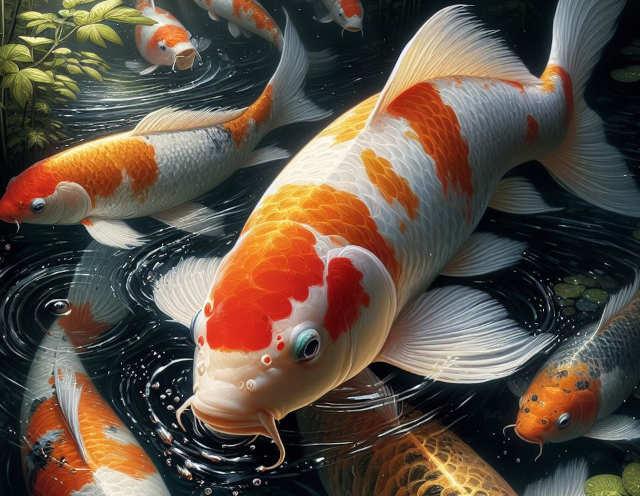It is in Japan, the birthplace of koi breeding, where these ornamental carp hold a special place in cultural lore and mythology. This article delves into the captivating tales and folklore surrounding koi fish in Japanese tradition.
Exploring Mythical Origins
The Legend of the Dragon Gate
One of the most enduring myths surrounding koi fish originates from China and later found its way into Japanese folklore. According to legend, there was a mythical waterfall known as the Dragon Gate, located on the Yellow River. It was believed that any carp that successfully leaped over the Dragon Gate would transform into a dragon. Despite the treacherous currents and towering cascade, the koi fish were determined to surmount this formidable obstacle. Those that succeeded were said to ascend to the heavens as celestial dragons, symbolizing the triumph of perseverance over adversity and the attainment of greatness through unwavering determination.
Symbolism of Transformation
The tale of the Dragon Gate resonates deeply with the symbolic significance of koi fish in Eastern cultures. Beyond their ornamental beauty, koi are revered as symbols of personal growth, evolution, and the realization of one's potential. The transformative journey of the koi, from humble carp to majestic dragon, embodies the human desire for self-improvement, resilience in the face of challenges, and the belief in the power of perseverance to overcome obstacles and achieve greatness.
Cultural Reverence and Spiritual Significance
In Japan, where koi breeding and appreciation reached new heights of sophistication, the legend of the Dragon Gate became intertwined with cultural beliefs and spiritual practices. Koi fish came to symbolize not only success and prosperity but also enlightenment and spiritual awakening. The image of the ascending koi, transcending earthly limitations to become a celestial dragon, resonated deeply with the Zen philosophy of self-realization and the quest for enlightenment.
Koi in Art and Literature:
Koi in Visual Art
Throughout history, koi fish have been a recurring subject in visual art, spanning a wide range of mediums and styles. In traditional Japanese art, koi are often depicted in serene pond settings, their vibrant hues shimmering against the tranquil waters. From delicate ink wash paintings to intricate woodblock prints, artists have sought to capture the essence of koi fish, imbuing their representations with a sense of grace, harmony, and natural beauty. In contemporary art, koi continue to inspire creativity, appearing in vibrant acrylic paintings, intricate sculptures, and innovative mixed-media installations that push the boundaries of artistic expression.
Koi in Literature
In literature, koi fish have served as powerful symbols and metaphors, conveying themes of resilience, transformation, and the cyclical nature of life. In ancient Chinese poetry, koi are celebrated for their perseverance and determination, as seen in the famous legend of the Dragon Gate. Writers have drawn inspiration from this myth, weaving tales of koi fish overcoming adversity to achieve greatness or embarking on transformative journeys of self-discovery. From classic works of literature to modern-day novels, koi fish appear as recurring motifs that add depth and resonance to narrative themes, evoking a sense of wonder and contemplation in readers.
Inspiring Creativity
The timeless allure of koi fish continues to inspire creativity and innovation in artists and writers today. From breathtaking paintings and sculptures to evocative poems and stories, koi fish serve as a source of inspiration that transcends linguistic, cultural, and artistic boundaries. Whether as a muse for contemplation and reflection or a symbol of beauty and resilience, koi fish remain an enduring emblem of the human spirit's capacity for creativity, imagination, and expression.
Contemporary Relevance
Aesthetic Appeal and Symbolism
At the heart of the koi's popularity lies its aesthetic allure and profound symbolism. In Japanese culture, koi fish are revered for their vibrant colors, intricate patterns, and graceful movements, making them popular subjects in art, literature, and decorative motifs. Whether depicted in traditional paintings, contemporary sculptures, or ornamental ponds, koi fish serve as reminders of the beauty and resilience inherent in the natural world.
Zen Aesthetics and Spiritual Connection
The popularity of koi fish in modern Japanese culture is also intertwined with the principles of Zen Buddhism and the appreciation of nature's beauty. In Zen philosophy, koi fish symbolize qualities such as tranquility, harmony, and the cyclical nature of existence, reflecting the interconnectedness of all living beings. The act of observing koi fish in a tranquil pond is often likened to a meditative experience, allowing individuals to find solace and inspiration amidst life's chaos. As such, koi ponds and gardens have become popular features in Japanese temples, parks, and residential spaces, providing sanctuaries of serenity in urban landscapes.
Cultural Traditions and Festivals
Throughout Japan, the popularity of koi fish is celebrated through various cultural traditions and festivals. One such event is Children's Day (Kodomo no Hi), held annually on May 5th, where families display colorful koi-shaped windsocks known as "koinobori" to symbolize strength, success, and prosperity for their children. Similarly, koi fish are featured prominently in traditional celebrations such as weddings, New Year's festivities, and temple ceremonies, serving as auspicious symbols of blessings and good fortune.
Modern Trends and Urban Living
In recent years, the popularity of koi fish has extended beyond traditional settings into urban environments and contemporary lifestyles. Many Japanese enthusiasts have embraced koi keeping as a hobby, creating miniature ponds and aquascapes in their homes and gardens. Additionally, koi-themed merchandise, including clothing, accessories, and home decor, has become increasingly popular, reflecting a growing appreciation for the aesthetic and cultural significance of these magnificent creatures.
